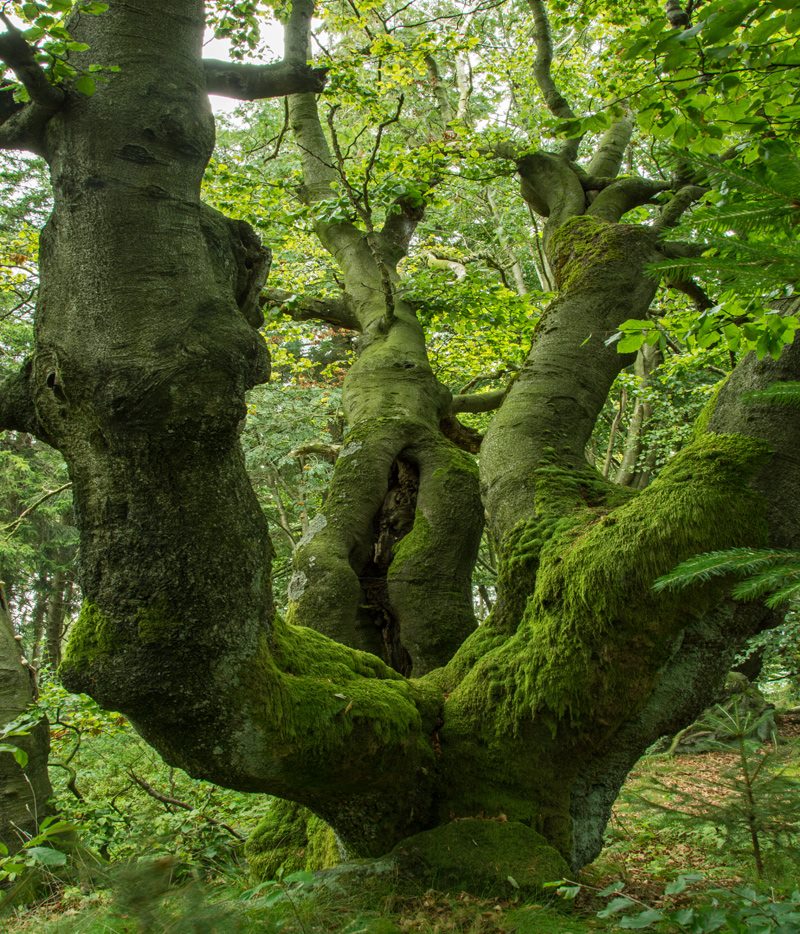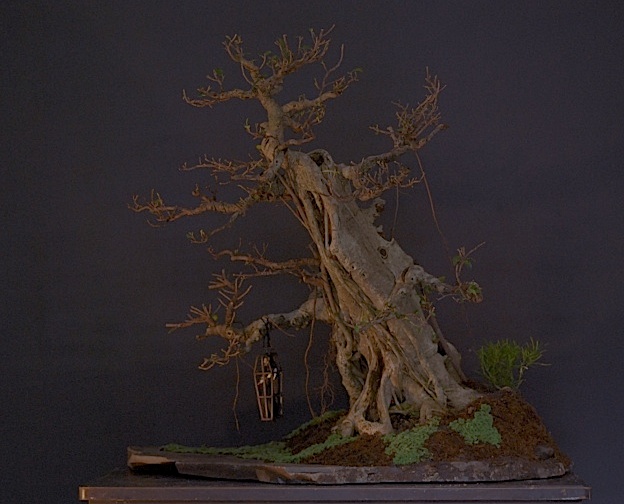The Fairy Tale Bonsai Style
+19
Justin Hervey
luciano benyakob
bucknbonsai
Nomiyama Bonsai
tman15
MichaelJ
pitu
Richard S
keylyn
raregog
Down Under Jason
fiona
Arthur Joura
lennard
Todd Ellis
Khaimraj Seepersad
MKBonsai
LittleJoe
Walter Pall
23 posters
Page 1 of 2
Page 1 of 2 • 1, 2 
 The Fairy Tale Bonsai Style
The Fairy Tale Bonsai Style
19:27:42The Fairy Tale Bonsai Style (FTS)
by Walter Pall
www.walter-pall.de
When the International Bonsai Academy was at Sebastijan Sandev's place in summer of 2o13 Sebastijan and I noticed that our ideas about styling some trees were so far away from standard bonsai that we better call it something else.
This is how this all came abut:
"And Sarah and John left their home in the afternoon because their mother had told them that she could not feed them anymore and would sell them to the rich farmers who would keep them like slaves. So the children walked away into the woods holding their hands. They went deeper and deeper into the forest and became quite afraid. It was getting dark and the forest made it even darker. The children felt without protection against all the wild animals and the ghosts and the evil ones. They became very tired and finally saw this enormous tree from far away. They were scared of the size, the mighty trunk and the branches which were so thick like other trees and moved into all directions like an octopus. They almost did not dare to get closer. But since they had no choice they finally arrived at the tree, which was even mightier than it had looked before. And they crawled over the enormous roots and found this crevice in the trunk which was large enough for both of them to enter. There they felt safe and fell asleep. Then at midnight they woke up because the tree spoke in a deep, gentle voice to them and asked them to crawl out. He wanted to show them the forest and introduce them to all the animals and to the other trees. And Sarah and Joe knew they were in a save place and loved the tree. From then on trees meant something very special to them."



This is the trees that we try to create. It has not much to do with what bonsai normally is other than that it is in a container, often not even in a pot. It is mighty, spooky, grotesque, appearing monstrous but being very warm and friendly, a tree that it so ugly that it is beautiful again. He does not know that he is ugly, and he does not care. Much more important is friendship and shelter for many. It is a giving tree, a very soft core in a very hard shell.


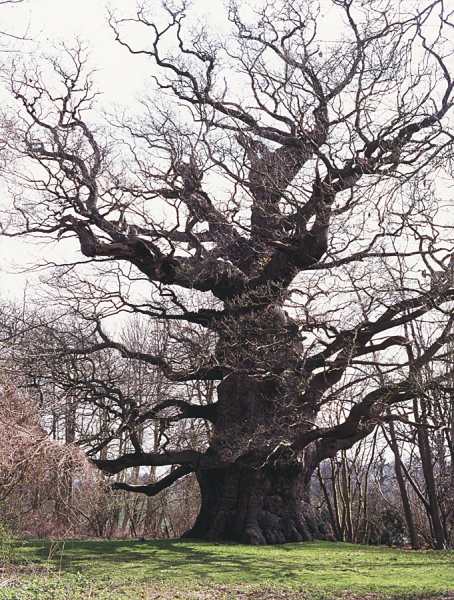



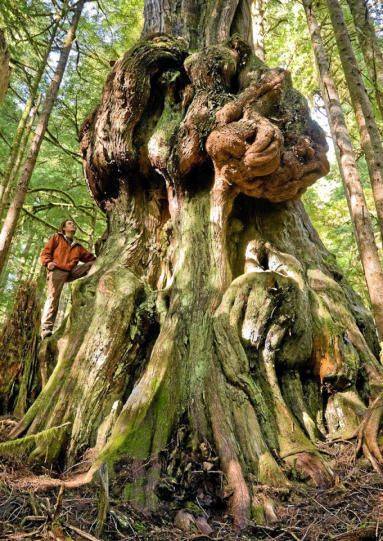


How does one go about creating tree in the FTS? First the material is most important. It does not make sense in general to force whatever form and style one is determined to create onto any piece of material. The tree will tell you what it wants to become. What one gets as bonsai material in general is not suitable for this kind of style, it usually is suitable to become a standard bonsai. But the 'impossible' material, the monstrous collected tree which has so many options but not a single 'good' one, the last dog, they can well be good material for the FTS. One of the great advantages of this style actually is that otherwise worthless material can be used for great results. But this is not the real reason to work in this style. Some will spread the word though that it is and we should ignore them. They won't get it, anyway. There must be something in this chaotic tree that you see which makes some sense. But sense in a fairy tale way and not in a bonsai way. It can be a monstrous nebari, or very strangely growing branches, or huge wounds which could be spooky hollows.
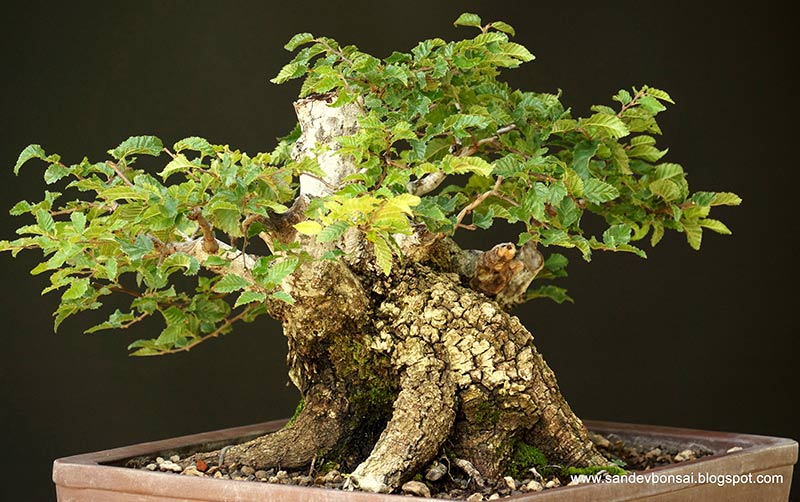
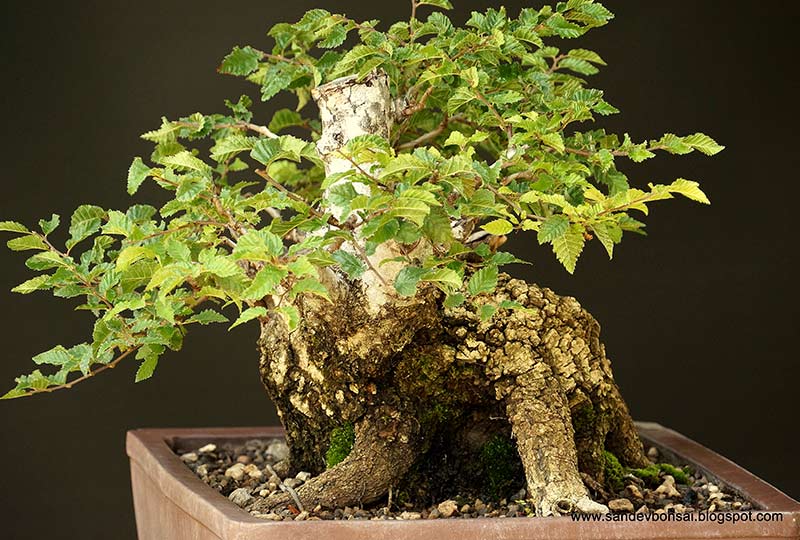
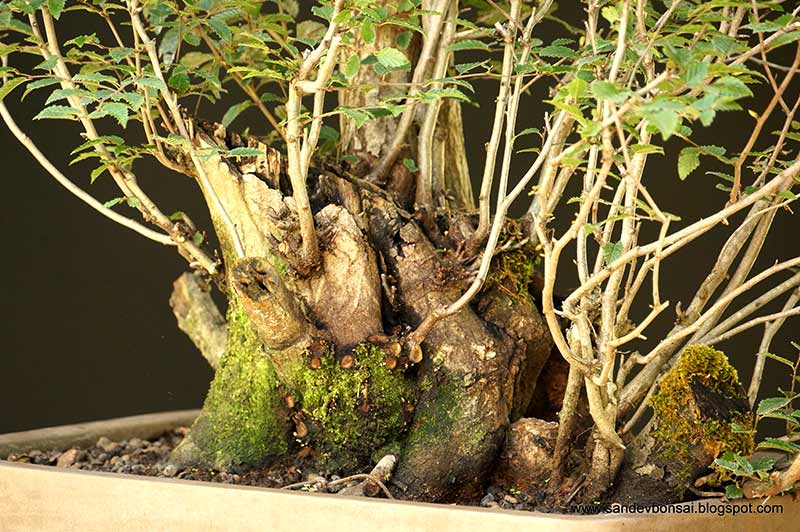


Here some bonsai in the FTS:
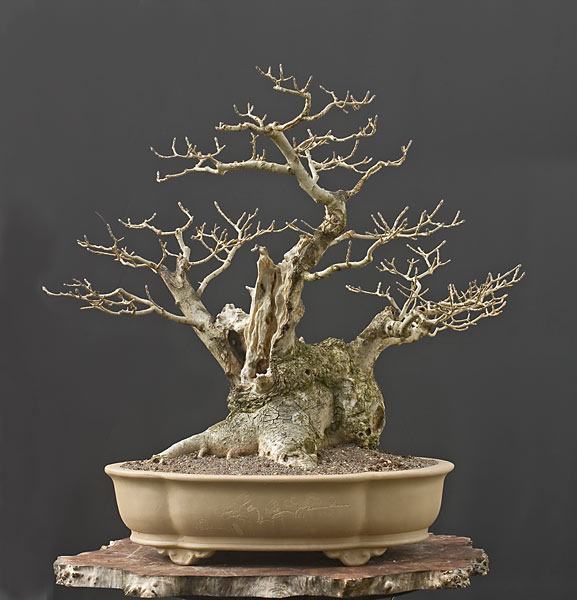

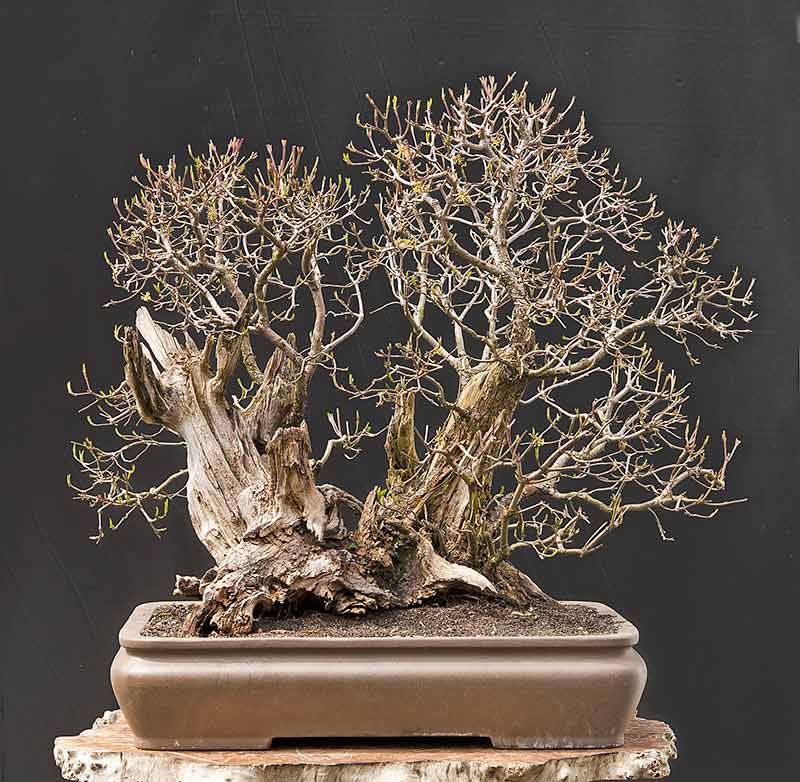


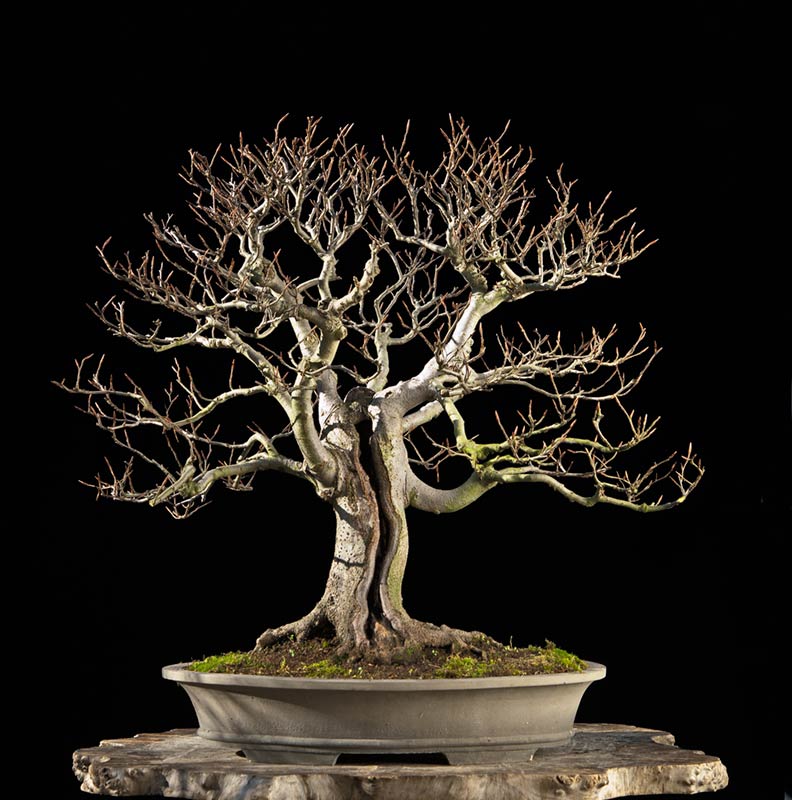
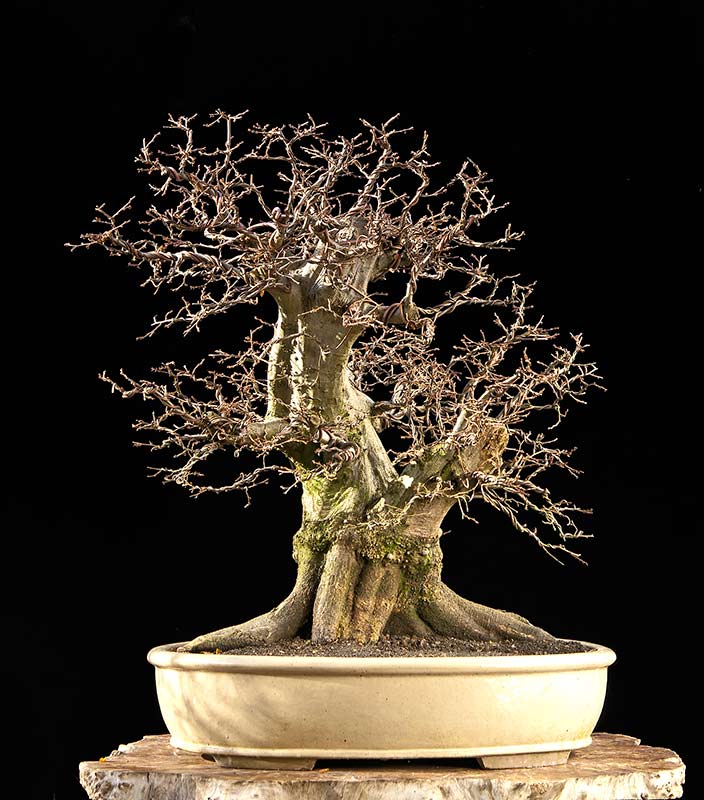



What's the difference between the FTS and the naturalistic Style? First let's see what they have in common. Both are controversial. This is a given if something threatens the bonsai establishment. Both are here since a long time already, but hardly noticed. The Chinese have done naturalistic and fairy tale trees since a very long time. Both seem to be easy, but are more difficult to do well than a so called classical bonsai in the neoclassical bonsai style. Both are striving to create a tree and absolutely not a typical bonsai. Both want to give the tree a soul so that it can speak.
Now the differences. While in the naturalistic style one usually tries to create something beautiful this is not the object in the FTS. There one tries to create something, impressive, unique, dominating in a nice way.
This all is in the very beginning and there will be many more examples. This is only to start the discussions.
by Walter Pall
www.walter-pall.de
When the International Bonsai Academy was at Sebastijan Sandev's place in summer of 2o13 Sebastijan and I noticed that our ideas about styling some trees were so far away from standard bonsai that we better call it something else.
This is how this all came abut:
"And Sarah and John left their home in the afternoon because their mother had told them that she could not feed them anymore and would sell them to the rich farmers who would keep them like slaves. So the children walked away into the woods holding their hands. They went deeper and deeper into the forest and became quite afraid. It was getting dark and the forest made it even darker. The children felt without protection against all the wild animals and the ghosts and the evil ones. They became very tired and finally saw this enormous tree from far away. They were scared of the size, the mighty trunk and the branches which were so thick like other trees and moved into all directions like an octopus. They almost did not dare to get closer. But since they had no choice they finally arrived at the tree, which was even mightier than it had looked before. And they crawled over the enormous roots and found this crevice in the trunk which was large enough for both of them to enter. There they felt safe and fell asleep. Then at midnight they woke up because the tree spoke in a deep, gentle voice to them and asked them to crawl out. He wanted to show them the forest and introduce them to all the animals and to the other trees. And Sarah and Joe knew they were in a save place and loved the tree. From then on trees meant something very special to them."



This is the trees that we try to create. It has not much to do with what bonsai normally is other than that it is in a container, often not even in a pot. It is mighty, spooky, grotesque, appearing monstrous but being very warm and friendly, a tree that it so ugly that it is beautiful again. He does not know that he is ugly, and he does not care. Much more important is friendship and shelter for many. It is a giving tree, a very soft core in a very hard shell.









How does one go about creating tree in the FTS? First the material is most important. It does not make sense in general to force whatever form and style one is determined to create onto any piece of material. The tree will tell you what it wants to become. What one gets as bonsai material in general is not suitable for this kind of style, it usually is suitable to become a standard bonsai. But the 'impossible' material, the monstrous collected tree which has so many options but not a single 'good' one, the last dog, they can well be good material for the FTS. One of the great advantages of this style actually is that otherwise worthless material can be used for great results. But this is not the real reason to work in this style. Some will spread the word though that it is and we should ignore them. They won't get it, anyway. There must be something in this chaotic tree that you see which makes some sense. But sense in a fairy tale way and not in a bonsai way. It can be a monstrous nebari, or very strangely growing branches, or huge wounds which could be spooky hollows.





Here some bonsai in the FTS:










What's the difference between the FTS and the naturalistic Style? First let's see what they have in common. Both are controversial. This is a given if something threatens the bonsai establishment. Both are here since a long time already, but hardly noticed. The Chinese have done naturalistic and fairy tale trees since a very long time. Both seem to be easy, but are more difficult to do well than a so called classical bonsai in the neoclassical bonsai style. Both are striving to create a tree and absolutely not a typical bonsai. Both want to give the tree a soul so that it can speak.
Now the differences. While in the naturalistic style one usually tries to create something beautiful this is not the object in the FTS. There one tries to create something, impressive, unique, dominating in a nice way.
This all is in the very beginning and there will be many more examples. This is only to start the discussions.
Last edited by Walter Pall on Sun Feb 02, 2014 7:00 pm; edited 1 time in total

Walter Pall- Member
 The Fairy Tale Bonsai Style
The Fairy Tale Bonsai Style
Dear Walter,
I very much agree and like your views on this subject.
I do get a little bored looking at bonsai with the same profiles. The new direction you talk about is, to me, much more interesting. It also allows otherwise "poor" material to be transformed into something wonderful, and much more natural looking.
An example I have where I hope this is the case is shown here. Whilst this tree has been abused by man, it's character has developed totally naturally following its repeated battles to survice the abuse it has been given by lanscape groundsmen. It has fantastic, rugged features that would be lost by trying to turn it into a classical bonsai style - which it is unlikely to be transformed into anyway as it has too many "faults". To me it has great potential as a fairy tale tree however and I look forward to the challenge of developing it accordingly.

I very much agree and like your views on this subject.
I do get a little bored looking at bonsai with the same profiles. The new direction you talk about is, to me, much more interesting. It also allows otherwise "poor" material to be transformed into something wonderful, and much more natural looking.
An example I have where I hope this is the case is shown here. Whilst this tree has been abused by man, it's character has developed totally naturally following its repeated battles to survice the abuse it has been given by lanscape groundsmen. It has fantastic, rugged features that would be lost by trying to turn it into a classical bonsai style - which it is unlikely to be transformed into anyway as it has too many "faults". To me it has great potential as a fairy tale tree however and I look forward to the challenge of developing it accordingly.


MKBonsai- Member
 Re: The Fairy Tale Bonsai Style
Re: The Fairy Tale Bonsai Style
Walter,
to be frank, to get to that stage would require a lot more design work, than I saw in the earlier bonsai attempts.
The paintings are designed for the subject, such as Old Man Willow, by Hildebrandt.
I wish you all the success, that is going to be a lot of effort.
Later.
Khaimraj
to be frank, to get to that stage would require a lot more design work, than I saw in the earlier bonsai attempts.
The paintings are designed for the subject, such as Old Man Willow, by Hildebrandt.
I wish you all the success, that is going to be a lot of effort.
Later.
Khaimraj
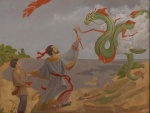
Khaimraj Seepersad- Member
 Re: The Fairy Tale Bonsai Style
Re: The Fairy Tale Bonsai Style
To find these old growth trees in this part of the country (Mid-Atlantic states) is very rare, because most all of the timber was cut during, and right after, the US Civil War; lumber, firewood, charcoal, etc. However, there are a few of them around and nothing compares to the excitement I feel when I encounter such trees. I like the FTS concept; there have been previous threads in IBC concerning "Ents" from the Hobbit Trilogy... definitely Fairy Tales for sure! I think "sumo" bonsai fall into this realm as well; there has been a lot of controversy here too. Also, many exposed root designs seem to deviate from the norm. Penjing has taught us that "anything" is possible. The use of developing contorted roots into becoming supporting trunks has long been favored by Penjing growers. The main challenge for me is learning how to preserve these characteristics from rotting.
Great thread Walter!
Great thread Walter!
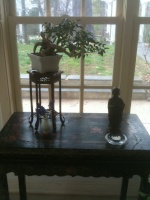
Todd Ellis- Member
 Re: The Fairy Tale Bonsai Style
Re: The Fairy Tale Bonsai Style
Thanks Walter for the explanation and double thanks for using one of my works as an example of FTS.
Creating a believable image as what the creator sees in his mind is really not that easy. And I bet every creation would be very unique even for the artist own collection, because of the raw material factor which will dictate the outcome of the artist vision.
regards,
jun
Creating a believable image as what the creator sees in his mind is really not that easy. And I bet every creation would be very unique even for the artist own collection, because of the raw material factor which will dictate the outcome of the artist vision.
regards,
jun
Guest- Guest
 Fantasy trees.
Fantasy trees.
Having a vivid imagination I have a few of these personified trees.
To do the natural form and with that, the naturalistic styling of branches, as also with this form, one must just be careful to not use it as an excuse to grow sloppy trees.
Nature do grow ugly trees also.
Lennard
To do the natural form and with that, the naturalistic styling of branches, as also with this form, one must just be careful to not use it as an excuse to grow sloppy trees.
Nature do grow ugly trees also.
Lennard
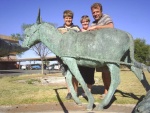
lennard- Member
 Uncle Walter Stirs the Soup (Once Again)
Uncle Walter Stirs the Soup (Once Again)
Hello Walter!
Thank you for this thread. I would like to add a few images to it, if you do not mind:
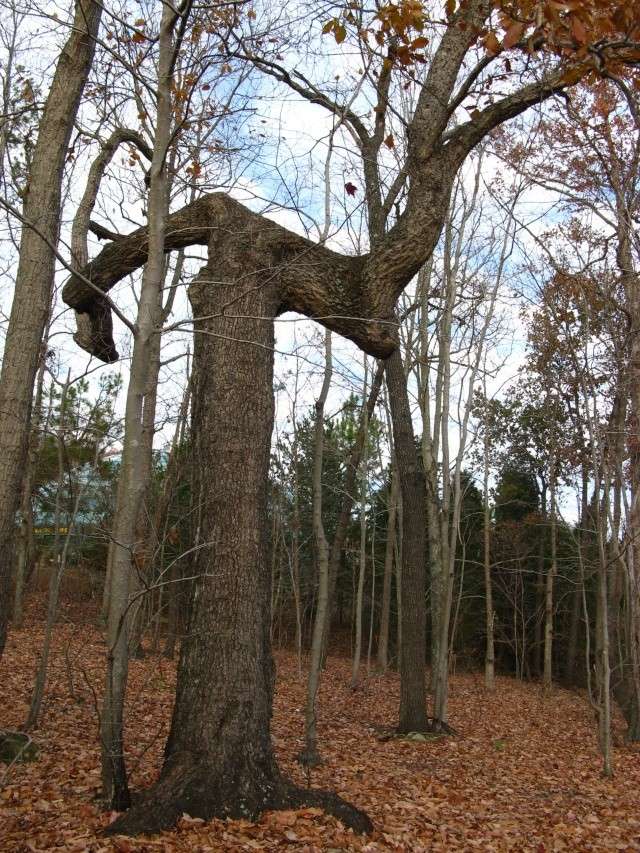





These I think of more as Naturalistic/Grotesque, rather than Fairy Tale trees, but I feel the same way about most of the images of your own fine work that you have posted here. You can call them what you like, of course, but in any case there needs to be a place for such trees in bonsai.
I am glad to see you continuing to be a leader in expanding the horizons of bonsai design, but why did you post this thread in "The Lounge" section of the forum? Many more people could see it if it was in one of the areas accessible to non-members.
Thank you for this thread. I would like to add a few images to it, if you do not mind:






These I think of more as Naturalistic/Grotesque, rather than Fairy Tale trees, but I feel the same way about most of the images of your own fine work that you have posted here. You can call them what you like, of course, but in any case there needs to be a place for such trees in bonsai.
I am glad to see you continuing to be a leader in expanding the horizons of bonsai design, but why did you post this thread in "The Lounge" section of the forum? Many more people could see it if it was in one of the areas accessible to non-members.

Arthur Joura- Member
 Re: The Fairy Tale Bonsai Style
Re: The Fairy Tale Bonsai Style
Arthur Joura wrote:
I am glad to see you continuing to be a leader in expanding the horizons of bonsai design, but why did you post this thread in "The Lounge" section of the forum? Many more people could see it if it was in one of the areas accessible to non-members.
Good question, Arthur. If you look at the sections available then this is the only one that I could have posted it.
Anyway, the numbers of viewers here are minimal compared to more than 6,000 who have read it on facebook and more than 5,000 who have read it on my blog so far. Numbers don't really mean much though. It is more important that the right people read it.

Walter Pall- Member
 Re: The Fairy Tale Bonsai Style
Re: The Fairy Tale Bonsai Style
Great artcile, I originally read it on your blog and loved it, very thought provoking.
Down Under Jason- Member
 Thughts?
Thughts?
I have enjoyed what i have seen and read, but wonder what conception of Bonsai would Pabblo Picaaso have brought to the table.?
raregog- Member
 Re: The Fairy Tale Bonsai Style
Re: The Fairy Tale Bonsai Style
you wouldn't mind if i add some - in fact, these trees compromise most of my collection in training, since i started working with trees one year ago.
tabernaemontana pandacaqui


gmelina exotica hollowed side before (my fave)


a lantana with exposed roots started from a dinky and shrimpy looking cutting (one of my first garden plants)

tabernaemontana pandacaqui


gmelina exotica hollowed side before (my fave)


a lantana with exposed roots started from a dinky and shrimpy looking cutting (one of my first garden plants)

keylyn- Member
 Re: The Fairy Tale Bonsai Style
Re: The Fairy Tale Bonsai Style
Great thread and a great concept.
I love those fairy tale style bonsai. They do a good job of invoking the feel of the ancient wild woods that so dominate the landscape of European folk tales and fairy stories. Primeval, mysterious, maybe even slightly surreal but why not also go for something a little darker?
I don't have any trees like this myself but I think that the Elm in quatrefi's recent post fits the bill nicely!
https://ibonsaiclub.forumotion.com/t14935-ulmus-parvifolia
This may not be "fairy tale" (more like nightmare) and it's a lot less naturalistic but it's definitely a fantasy style. Not quite evil but certainly sinister, disturbing and unsettling.
Maybe even a touch of Lovecraft's Cthulhu about it. Are those branches or tentacles?
Regards
Richard
I love those fairy tale style bonsai. They do a good job of invoking the feel of the ancient wild woods that so dominate the landscape of European folk tales and fairy stories. Primeval, mysterious, maybe even slightly surreal but why not also go for something a little darker?
I don't have any trees like this myself but I think that the Elm in quatrefi's recent post fits the bill nicely!
https://ibonsaiclub.forumotion.com/t14935-ulmus-parvifolia
This may not be "fairy tale" (more like nightmare) and it's a lot less naturalistic but it's definitely a fantasy style. Not quite evil but certainly sinister, disturbing and unsettling.
Maybe even a touch of Lovecraft's Cthulhu about it. Are those branches or tentacles?
Regards
Richard

Richard S- Member
 Re: The Fairy Tale Bonsai Style
Re: The Fairy Tale Bonsai Style
Your article has made me reconsider some "basics" of the work with trees.
Thanks Walter
Thanks Walter
pitu- Member
 Re: The Fairy Tale Bonsai Style
Re: The Fairy Tale Bonsai Style
I like this concept, but I have almost no idea how to implement it in my own collection.
MichaelJ- Member
 FSB Fairytale Style Bonsai
FSB Fairytale Style Bonsai
Yes, this is why we love you Walter, you are always kicking our but / brains about Bonsai.
I note that most of these trees are deciduous, all are very, very old.
For pines or junipers we would not think of them in the deep dark scary woods, or
the deep light friendly woods, but rather on the mountain tops crushed by the
elements of snow, ice and cold. These trees are as rare in bonsai as they are in
nature. I think of classical Japanese bonsai of the flowering Prunis type. Many of those
great trees have the crushed, broken, twisted, scaly, rough trunks with rotten holes in
them, even if the small twisted new growth has elegant flowers. And as you say the
Chinese have been doing this for a while. This just shows where you have to go with
a certain kind of collected material, and again, nature is a guide as the photos prove.
Bob Thatcher
Asheville, NC
I note that most of these trees are deciduous, all are very, very old.
For pines or junipers we would not think of them in the deep dark scary woods, or
the deep light friendly woods, but rather on the mountain tops crushed by the
elements of snow, ice and cold. These trees are as rare in bonsai as they are in
nature. I think of classical Japanese bonsai of the flowering Prunis type. Many of those
great trees have the crushed, broken, twisted, scaly, rough trunks with rotten holes in
them, even if the small twisted new growth has elegant flowers. And as you say the
Chinese have been doing this for a while. This just shows where you have to go with
a certain kind of collected material, and again, nature is a guide as the photos prove.
Bob Thatcher
Asheville, NC
tman15- Member
 Re: The Fairy Tale Bonsai Style
Re: The Fairy Tale Bonsai Style
Thank you Walter for this eye opening thought provoking concept on what can be done with the FTS. I do love it as I can appreciate the ancient trees in nature that we are trying to mimic. I will now be on the look out for candidates to fit this mold in my personal collection, as I feel it would be fitting to have something that could come close to the FTS on my benches. What was once considered ugly or not "bonsai" because of flaws can now be given a new lease on life in the concept of creating FTS. I think this is great, thanks for being a wolf and not a sheep!! We need more wolves in bonsai.
Chris
Chris
Nomiyama Bonsai- Member
 Re: The Fairy Tale Bonsai Style
Re: The Fairy Tale Bonsai Style
Arthur,
Is your last image from craggy gardens?
thanks,
alex
Is your last image from craggy gardens?
thanks,
alex

bucknbonsai- Member
 Re: The Fairy Tale Bonsai Style
Re: The Fairy Tale Bonsai Style
Nice job, Jun! The creepy effect of the tree would work just as well for me without the torture devise dangling from it, but you have your own way of doing these things.
Alex - Good eye recognizing that tree! It is indeed in the Craggy area of western NC, along the trail up to Craggy Pinnacle. Here is another shot of it:

It is a Yellow Birch (Betula alleghaniensis) and it usually makes me think of an octopus.
Alex - Good eye recognizing that tree! It is indeed in the Craggy area of western NC, along the trail up to Craggy Pinnacle. Here is another shot of it:

It is a Yellow Birch (Betula alleghaniensis) and it usually makes me think of an octopus.

Arthur Joura- Member
 Re: The Fairy Tale Bonsai Style
Re: The Fairy Tale Bonsai Style
Here in Brazil, perhaps the new generation can understand this kind of beauty ...
Shabbat Shalom Luciano.
Shabbat Shalom Luciano.

luciano benyakob- Member
 Re: The Fairy Tale Bonsai Style
Re: The Fairy Tale Bonsai Style
Exactly!!! This olive is almost a scenery and will be absolutely beautiful as a fairy tale tree!
Kiefer- Member
Page 1 of 2 • 1, 2 
 Similar topics
Similar topics» VIDEO: INTERNATIONAL BONSAI ACADEMY by Walter Pall 2013. Episode I
» Carpinus in a pure fairy tale style
» The Old Oak Style – A possibility for Bonsai??
» Suggest bonsai style
» wrightia religiosa multitrunk bonsai style
» Carpinus in a pure fairy tale style
» The Old Oak Style – A possibility for Bonsai??
» Suggest bonsai style
» wrightia religiosa multitrunk bonsai style
Page 1 of 2
Permissions in this forum:
You cannot reply to topics in this forum










